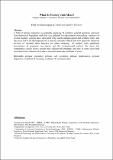Files in this item
What do monkey calls mean?
Item metadata
| dc.contributor.author | Schlenker, Philippe | |
| dc.contributor.author | Chemla, Emmanuel | |
| dc.contributor.author | Zuberbühler, Klaus | |
| dc.date.accessioned | 2017-11-10T00:33:15Z | |
| dc.date.available | 2017-11-10T00:33:15Z | |
| dc.date.issued | 2016-12 | |
| dc.identifier | 247145646 | |
| dc.identifier | ad719477-f458-4676-975e-9494945dc633 | |
| dc.identifier | 85002621832 | |
| dc.identifier | 000389106600004 | |
| dc.identifier.citation | Schlenker , P , Chemla , E & Zuberbühler , K 2016 , ' What do monkey calls mean? ' , Trends in Cognitive Sciences , vol. 20 , no. 12 , pp. 894-904 . https://doi.org/10.1016/j.tics.2016.10.004 | en |
| dc.identifier.issn | 1364-6613 | |
| dc.identifier.other | ORCID: /0000-0001-8378-088X/work/64360707 | |
| dc.identifier.uri | https://hdl.handle.net/10023/12043 | |
| dc.description | Grant acknowledgements: Chemla and Schlenker: Research by Schlenker and Chemla was conducted at Institut d’Etudes Cognitives, Ecole Normale Supérieure – PSL Research University. Institut d’Etudes Cognitives is supported by grants ANR-10-LABX-0087 IEC et ANR-10-IDEX-0001-02 PSL. Schlenker: The research leading to these results received funding from the European Research Coucil under the European Union’s Seventh Framework Programme (FP/2007- 2013) / ERC Grant Agreement n°324115-FRONTSEM (PI:Schlenker). Zuberbühler: The research leading to these results received funding from the European Research Council under ERC grant ‘Prilang 283871’ and also from the Swiss National Science Foundation under grant ‘FN 310030_143359/1’. The project also benefited from the support of the Centre Suisse de Recherches Scientifiques en Côte d'Ivoire and Taï Monkey Project. | en |
| dc.description.abstract | A field of primate linguistics is gradually emerging. It combines general questions and tools from theoretical linguistics with rich data gathered in experimental primatology. Analyses of several monkey systems have uncovered very simple morphological and syntactic rules, and they have led to the development of a primate semantics which asks new questions about the division of semantic labor between the literal meaning of monkey calls, additional mechanisms of pragmatic enrichment, and the environmental context. We show that comparative studies across species may validate this program, and may in some cases help reconstruct the evolution of monkey communication over millions of years. | |
| dc.format.extent | 11 | |
| dc.format.extent | 550176 | |
| dc.language.iso | eng | |
| dc.relation.ispartof | Trends in Cognitive Sciences | en |
| dc.subject | Primate semantics | en |
| dc.subject | Primate call evolution | en |
| dc.subject | Primate implicatures | en |
| dc.subject | Primate linguistics | en |
| dc.subject | Evolution of meaning | en |
| dc.subject | Evolution of communication | en |
| dc.subject | BF Psychology | en |
| dc.subject | NDAS | en |
| dc.subject.lcc | BF | en |
| dc.title | What do monkey calls mean? | en |
| dc.type | Journal article | en |
| dc.contributor.institution | University of St Andrews. School of Psychology and Neuroscience | en |
| dc.contributor.institution | University of St Andrews. Institute of Behavioural and Neural Sciences | en |
| dc.contributor.institution | University of St Andrews. Centre for Social Learning & Cognitive Evolution | en |
| dc.identifier.doi | https://doi.org/10.1016/j.tics.2016.10.004 | |
| dc.description.status | Peer reviewed | en |
| dc.date.embargoedUntil | 2017-11-09 |
This item appears in the following Collection(s)
Items in the St Andrews Research Repository are protected by copyright, with all rights reserved, unless otherwise indicated.

